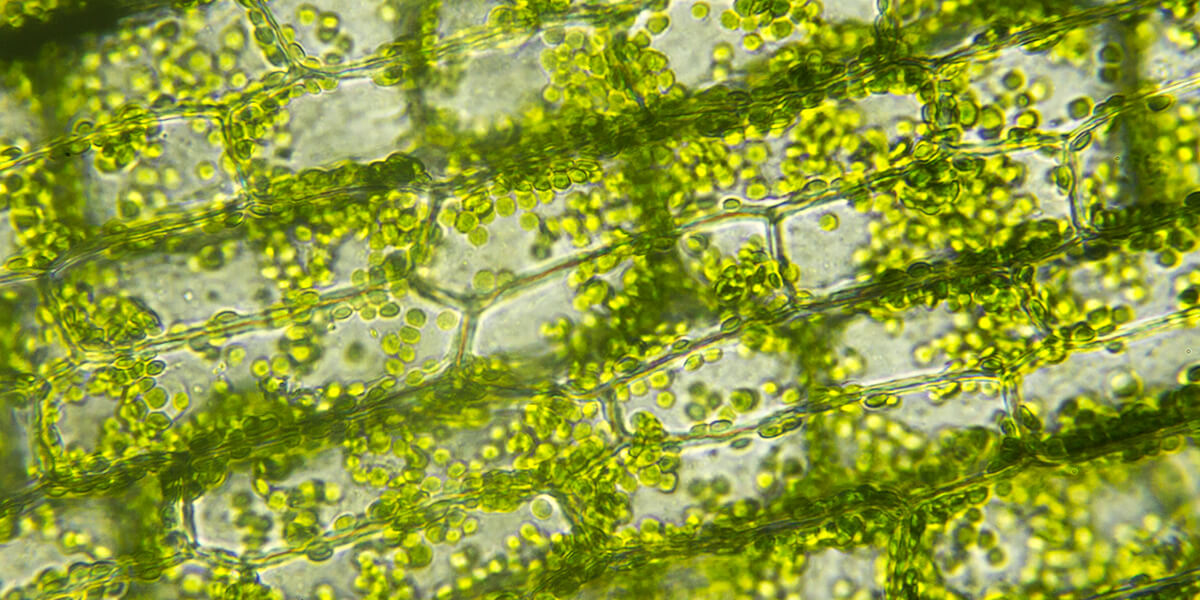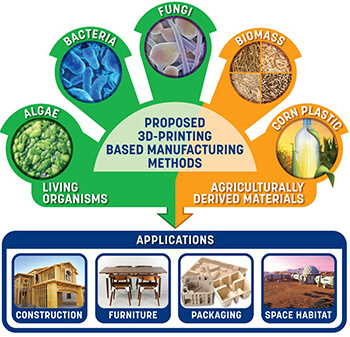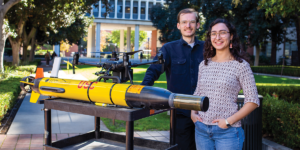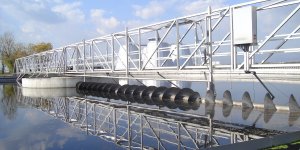
Magnification of algae cells: the building blocks for newly engineered “living” materials
Anyone who grew up watching the animations of Walt Disney or Hayao Miyazaki will already be accustomed to a world where objects and materials have their own inner life, grow, heal and transform.
For most of us, that world is consigned to childhood. For Professor Qiming Wang, the living potential of seemingly inanimate matter is a daily professional reality.
 As Stephen Schrank Early Career Chair in Civil and Environmental Engineering, his research taps into the power of living microorganisms to manufacture unprecedented self-healing and self-strengthening materials. Now, a $3 million Future Manufacturing Research Grant in Ecomanufacturing from the National Science Foundation is funding a groundbreaking research initiative in which Wang is co-principal investigator, in collaboration with researchers from Texas A&M University and Caltech.
As Stephen Schrank Early Career Chair in Civil and Environmental Engineering, his research taps into the power of living microorganisms to manufacture unprecedented self-healing and self-strengthening materials. Now, a $3 million Future Manufacturing Research Grant in Ecomanufacturing from the National Science Foundation is funding a groundbreaking research initiative in which Wang is co-principal investigator, in collaboration with researchers from Texas A&M University and Caltech.
The study “Sustainable Manufacturing Using Living Organisms and Agriculturally Derived Materials” is inspired by the biological systems that involve living cells in the metabolization of biomass – comparable to the process of composting. The goal is to enable 3D printing-based methods that reprocess and activate agriculturally derived waste materials, such as discarded grass and biodegradable corn plastics. The secret agents in this process? Living microorganisms, including bacteria, algae and fungi.
Magical mugs and life on Mars
The research study is a neat way of addressing two major problems facing our overstretched planet: the build-up and waste of agricultural byproducts, and the need to efficiently repair and maintain engineered materials.
“Agriculturally derived materials have been grossly undervalued and misused,” said Wang. “For example, the majority of biomass is classed as solid waste that is downcycled as fire fuel or fertilizer, or shipped to landfills”
The proposed approach uses biocomposites with living organisms to manufacture sustainable products that have traditionally been made of petroleum-based plastics or natural wood. Taking on some of the properties of living organisms, these products would have the ability to heal like wounds or rapidly self-generate in the case of emergencies.

“We tend to make a strict distinction between non-living fabricated materials, and organisms such as trees and animals – natural structures made of cells that change and grow,” said Wang. The applications of this research could range from repairs to objects — imagine the shattered fragments of your favorite mug fusing back together — to the upkeep of large-scale infrastructure systems, such as urban subways, airplane runways, and networks of roads and bridges.
Wang also envisions the method being used for the mass production of emergency housing and the self-healing of construction materials in response to natural disasters. From there, his imagination leaps to extraterrestrial possibilities. “Another potential application is the construction of shelters on Mars. You could bring microorganisms from Earth, and then combine with available raw matter to generate new materials.”
Building back with bacteria
Wang proposes that one of the first applications of the method could be the manufacture of furniture and packaging materials – think of the expandable foam protecting your latest impulse buy, or the inflatable plastic that fills those notorious brown boxes.
The research process is split according to different categories of living organisms. Wang is investigating the potential application of bacteria, while other researchers are focusing on fungi and algae.
“To imagine the types of materials we’re creating, it’s helpful to think of the texture and cushioning properties of an egg box,” said Wang. “The fragile eggs are protected by the way that the egg box restricts the motion of the eggs and dissipates energy – we call that ‘damping.’ If you crush the materials into powder and add bacteria as a living binding agent, you can use the 3D-printing method to rebuild the original shape. In this way, you can reuse the materials for almost infinite cycles. The surface of the bacteria is covered with hairs that bind to the miniscule particles like glue, forming strong bonds and transforming the powder into a strong solid material – with just a bit of bounce.”
A strategic vision for collective well-being
In the coming years, it’s likely that we’ll start to see the world more like Wang – not through a radical retraining of the mind, but simply because environmentally friendly products that can grow and heal will increasingly be part of everyday life.
The widespread use of the new method would create domestic manufacturing-related jobs, as well as using more materials readily available in the United States. Additionally, the project involves an education and workforce development plan to train students and professionals in the principles of ecomanufacturing. From prioritizing environmental stewardship, to engineering for disaster resilience, the project directly aligns with the NAE Grand Challenges for Engineering, and the strategic vision of the Sonny Astani Department of Civil and Environmental Engineering.
There’s also a potential mental health benefit to taking on the mindset of Wang and his team.
As more and more of the materials around us appear to have life, it’s likely to have a ripple effect on the way we go about our days and feel connected to our surroundings. For ancient philosophers and contemporary indigenous communities alike, it’s common sense that human beings are the living products of a living planet. Why not apply that way of thinking to the things we make?
Published on May 26th, 2023
Last updated on June 16th, 2023









